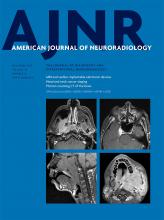Index by author
Meila, D.
- NeurointerventionYou have accessEndovascular Treatment of Vein of Galen Malformations: A Systematic Review and Meta-AnalysisW. Brinjikji, T. Krings, M.H. Murad, A. Rouchaud and D. MeilaAmerican Journal of Neuroradiology December 2017, 38 (12) 2308-2314; DOI: https://doi.org/10.3174/ajnr.A5403
Menon, B.K.
- NeurointerventionYou have accessCorrelation between Clinical Outcomes and Baseline CT and CT Angiographic Findings in the SWIFT PRIME TrialA.P. Jadhav, H.-C. Diener, A. Bonafe, V.M. Pereira, E.I. Levy, B.W. Baxter, T.G. Jovin, R.G. Nogueira, D.R. Yavagal, C. Cognard, D.D. Purcell, B.K. Menon, R. Jahan, J.L. Saver and M. Goyal on behalf of the SWIFT PRIME investigatorsAmerican Journal of Neuroradiology December 2017, 38 (12) 2270-2276; DOI: https://doi.org/10.3174/ajnr.A5406
Menon, R.S.
- Adult BrainOpen AccessInitial Investigation into Microbleeds and White Matter Signal Changes following Radiotherapy for Low-Grade and Benign Brain Tumors Using Ultra-High-Field MRI TechniquesJ.-G. Belliveau, G.S. Bauman, K.Y. Tay, D. Ho and R.S. MenonAmerican Journal of Neuroradiology December 2017, 38 (12) 2251-2256; DOI: https://doi.org/10.3174/ajnr.A5395
Meyers, G.C.
- NeurointerventionYou have accessWide Variability in Prethrombectomy Workflow Practices in the United States: A Multicenter SurveyA.P. Kansagra, G.C. Meyers, M.S. Kruzich, D.T. Cross and C.J. MoranAmerican Journal of Neuroradiology December 2017, 38 (12) 2238-2242; DOI: https://doi.org/10.3174/ajnr.A5384
Mignani, R.
- Adult BrainYou have accessRedefining the Pulvinar Sign in Fabry DiseaseS. Cocozza, C. Russo, A. Pisani, G. Olivo, E. Riccio, A. Cervo, G. Pontillo, S. Feriozzi, M. Veroux, Y. Battaglia, D. Concolino, F. Pieruzzi, R. Mignani, P. Borrelli, M. Imbriaco, A. Brunetti, E. Tedeschi and G. PalmaAmerican Journal of Neuroradiology December 2017, 38 (12) 2264-2269; DOI: https://doi.org/10.3174/ajnr.A5420
Moore, J.M.
- EDITOR'S CHOICENeurointerventionYou have accessPredictors of Incomplete Occlusion following Pipeline Embolization of Intracranial Aneurysms: Is It Less Effective in Older Patients?N. Adeeb, J.M. Moore, M. Wirtz, C.J. Griessenauer, P.M. Foreman, H. Shallwani, R. Gupta, A.A. Dmytriw, R. Motiei-Langroudi, A. Alturki, M.R. Harrigan, A.H. Siddiqui, E.I. Levy, A.J. Thomas and C.S. OgilvyAmerican Journal of Neuroradiology December 2017, 38 (12) 2295-2300; DOI: https://doi.org/10.3174/ajnr.A5375
This was a retrospective analysis of 465 consecutive aneurysms treated with the Pipeline Embolization Device between 2009 and 2016, at 3 academic institutions in the United States. Cases with angiographic follow-up were selected to evaluate factors predictive of incomplete aneurysm occlusion at last follow-up. Older age (more than 70 years), nonsmoking status, aneurysm location within the posterior communicating artery or posterior circulation, greater aneurysm maximal diameter (>21 mm), and shorter follow-up time (<12 months) were significantly associated with incomplete aneurysm occlusion at last angiographic follow-up.
Moran, C.J.
- NeurointerventionYou have accessWide Variability in Prethrombectomy Workflow Practices in the United States: A Multicenter SurveyA.P. Kansagra, G.C. Meyers, M.S. Kruzich, D.T. Cross and C.J. MoranAmerican Journal of Neuroradiology December 2017, 38 (12) 2238-2242; DOI: https://doi.org/10.3174/ajnr.A5384
Moret, J.
- You have accessWEB Device: Ready for Ruptured Aneurysms?J. Caroff, J. Moret and L. SpelleAmerican Journal of Neuroradiology December 2017, 38 (12) 2288; DOI: https://doi.org/10.3174/ajnr.A5367
Motiei-langroudi, R.
- EDITOR'S CHOICENeurointerventionYou have accessPredictors of Incomplete Occlusion following Pipeline Embolization of Intracranial Aneurysms: Is It Less Effective in Older Patients?N. Adeeb, J.M. Moore, M. Wirtz, C.J. Griessenauer, P.M. Foreman, H. Shallwani, R. Gupta, A.A. Dmytriw, R. Motiei-Langroudi, A. Alturki, M.R. Harrigan, A.H. Siddiqui, E.I. Levy, A.J. Thomas and C.S. OgilvyAmerican Journal of Neuroradiology December 2017, 38 (12) 2295-2300; DOI: https://doi.org/10.3174/ajnr.A5375
This was a retrospective analysis of 465 consecutive aneurysms treated with the Pipeline Embolization Device between 2009 and 2016, at 3 academic institutions in the United States. Cases with angiographic follow-up were selected to evaluate factors predictive of incomplete aneurysm occlusion at last follow-up. Older age (more than 70 years), nonsmoking status, aneurysm location within the posterior communicating artery or posterior circulation, greater aneurysm maximal diameter (>21 mm), and shorter follow-up time (<12 months) were significantly associated with incomplete aneurysm occlusion at last angiographic follow-up.
Mukherji, S.K.
- FELLOWS' JOURNAL CLUBHead and Neck ImagingYou have accessSetting the Stage for 2018: How the Changes in the American Joint Committee on Cancer/Union for International Cancer Control Cancer Staging Manual Eighth Edition Impact RadiologistsC.M. Glastonbury, S.K. Mukherji, B. O'Sullivan and W.M. LydiattAmerican Journal of Neuroradiology December 2017, 38 (12) 2231-2237; DOI: https://doi.org/10.3174/ajnr.A5409
The updated eighth edition of the Cancer Staging Manual of the American Joint Committee on Cancer will be implemented in January 2018. There are multiple changes to the head and neck section of the manual, which will be relevant to radiologists participating in multidisciplinary head and neck tumor boards and reading pretreatment head and neck cancer scans.








